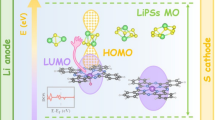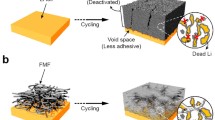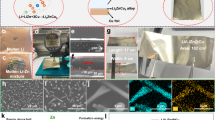Abstract
The interfacial characteristics of the Li metal anode (LMA) play a crucial role in its overall performance. Despite various materials being applied to modify the interface, a comprehensive understanding of their specific mechanisms remains to be investigated. Herein, we have prepared carbon cloth (CC) frameworks with their surfaces modified using ferromagnetic metal/LiF heterogeneous films (TM-LiF-CC) as the substrate for LMA, which exhibit superior electrochemical performance. Utilizing ferromagnetic Co as a representative example, our study demonstrates that the enhanced performance of Co-LiF-CC, compared to bare CC, is attributed to the spin-polarized interface contributed by the Co/LiF heterostructure. Co and LiF play individual roles in redistributing electrons and Li+ to promote homogeneous Li deposition. Co nanoparticles play a crucial role in generating strong surface capacitance by storing electrons in spin-split bands, while LiF, with low surface diffusion barriers, ensures fast transportation of Li+. The Co-LiF-CC@Li electrodes deliver long lives of 7400 and 3600 h at 1 and 2 mA·cm−2 in symmetric cells, respectively; moreover, they enable full batteries with high and durable capacities, particularly when the N/P ratios are low (3.3 or even 1.7).
Graphical Abstract

摘要
锂金属负极(LMA)的界面特性对其整体性能起着至关重要的作用。尽管有多种材料被用于界面改性,但其作用的具体机制仍有待研究。在此项工作中,我们制备了表面由铁磁性金属/氟化锂异质膜修饰的碳布骨架(TM-LiF-CC)作为锂金属负极的基底,其表现出优异的电化学性能。以铁磁性Co为例,与裸CC相比,Co-LiF-CC性能的提升得益于Co/LiF异质结构产生的自旋极化界面。Co和LiF能够重新分配电子和Li+,促进锂的均匀沉积。Co纳米颗粒在自旋分裂带中存储电子产生了强表面电容,而具有低表面扩散势垒的LiF促进了Li+的快速传输。因此,使用Co-LiF-CC@Li复合负极组装的对称电池在1和2 mA·cm-2的条件下分别稳定循环超过了7400和3600 h。同时,低N/P比的锂金属全电池表现出优异的循环性能。





Similar content being viewed by others
References
Tarascon JM, Armand M. Issues and challenges facing rechargeable lithium batteries. Nature. 2001;414(6861):359. https://doi.org/10.1038/35104644.
Liu YJ, Fang RY, Miltin D. NASICON solid electrolyte coated by indium film for all-solid-state Li-metal batteries. Tungsten. 2022;4(4):316. https://doi.org/10.1007/s42864-022-00183-0.
Gao XL, Liu XH, Xie WL, Zhang LS, Yang SC. Multiscale observation of Li plating for lithium-ion batteries. Rare Met. 2021;40(11):3038. https://doi.org/10.1007/s12598-021-01730-3.
Wu N, Zhang QY, Guo YJ, Zhou L, Zhang LJ, Wu MX, Wang WP, Yin YX, Sheng P, Xin S. Boron-doped three-dimensional MXene host for durable lithium-metal anode. Rare Met. 2022;41(7):2217. https://doi.org/10.1007/s12598-021-01944-5.
Chen J, Chen XL, Lu R, Li Y, Pan AQ. Necklace-like carbon nanofibers encapsulating MoO2 nanospheres with Mo–C bonding for stable lithium-ion storage. Rare Met. 2023;42(8):2592. https://doi.org/10.1007/s12598-022-02253-1.
Han WW, Ardhi REA, Liu GC. Dual impact of superior SEI and separator wettability to inhibit lithium dendrite growth. Rare Met. 2022;41(2):353. https://doi.org/10.1007/s12598-021-01878-y.
Tang TY, Zhang LG, Guo ZF, Gu XX. Development of cathode and anode materials in lithium sulfur batteries. Chin J Rare Met. 2022;46(7):954. https://doi.org/10.13373/j.cnki.cjrm.XY21070001.
Xie Y, Kong JR, Pan D, Liu XN, Zhou T. Preparation and Performance Study of La0.75Sr0.25Cr0.5Mn0.5O3-δ-Ce0.8Gd0.2O2-δ Gradient Composite Cathode for Solid Oxide Electrolysis Cell. Chin J Rare Met. 2021;45(11):1343. https://doi.org/10.13373/j.cnki.cjrm.xy19080033.
Chen LH, Huang ZY, Chen SL, Tong RA, Wang HL, Shao G, Wang CA. In situ polymerization of 1,3-dioxolane infiltrating 3D garnet framework with high ionic conductivity and excellent interfacial stability for integrated solid-state Li metal battery. Rare Met. 2022;41(11):3694. https://doi.org/10.1007/s12598-022-02080-4.
Luo L, Li JY, Ast HY, Manthiram A. A 3D lithiophilic Mo2N-modified carbon nanofiber architecture for dendrite-free lithium-metal anodes in a full cell. Adv Mater. 2019;31(48):1904537. https://doi.org/10.1002/adma.201904537.
Wang TS, Liu X, Wang Y, Fan LZ. High areal capacity dendrite-free Li anode enabled by metal-organic framework-derived nanorod array modified carbon cloth for solid state Li metal batteries. Adv Funct Mater. 2020;31(2):2001973. https://doi.org/10.1002/adfm.202001973.
Gou WW, Zhou S, Cao XX, Luo YL, Kong XZ, Chen J, Xie XF, Pan AQ. Agitation drying synthesis of porous carbon supported Li3VO4 as advanced anode material for lithium-ion batteries. Rare Met. 2021;40:3466. https://doi.org/10.1007/s12598-021-01712-5.
Zhou T, Shen J, Wang Z, Liu J, Hu R, Ouyang L, Feng Y, Liu H, Yu Y, Zhu M. Regulating lithium nucleation and deposition via MOF-derived Co@C-modified carbon cloth for stable Li metal anode. Adv Funct Mater. 2020;30(14):1909159. https://doi.org/10.1002/adfm.201909159.
Xiao GN, Cai WL, Zhu LQ, Fang YT, Ao HS, Zhu YC, Qian YT. N-Doped carbon nanotubes decorated with Fe/Ni sites to stabilize lithium metal anodes. Inorg Chem Front. 2020;7(15):2747. https://doi.org/10.1039/d0qi00501k.
Luan J, Zhang Q, Yuan H, Peng Z, Tang Y, Wu S, Wang H. Sn layer decorated copper mesh with superior lithiophilicity for stable lithium metal anode. Chem Eng J. 2020;395:124922. https://doi.org/10.1016/j.cej.2020.124922.
Ouyang Y, Cui C, Guo Y, Wei Y, Zhai T, Li H. In situ formed LiZn alloy skeleton for stable lithium anodes. ACS Appl Mater Interfaces. 2020;12(23):25818. https://doi.org/10.1021/acsami.0c04092.
Cao J, Xie Y, Li W, Wang X, Yang Y, Zhang Q, Guo J, Yang C, Cheng S, Zhang C, Wang K. Rationally optimized carbon fiber cloth as lithiophilic host for highly stable Li metal anodes. Mater Today Energy. 2021;20:100663. https://doi.org/10.1016/j.mtener.2021.100663.
Jiang G, Jiang N, Zheng N, Chen X, Mao J, Ding G, Li Y, Sun F, Li Y. MOF-derived porous Co3O4–NC nanoflake arrays on carbon fiber cloth as stable hosts for dendrite-free Li metal anodes. Energy Storage Mater. 2019;23:181. https://doi.org/10.1016/j.ensm.2019.05.014.
Geng P, Zheng S, Tang H, Zhu R, Zhang L, Cao S, Xue H, Pang H. Transition metal sulfides based on graphene for electrochemical energy storage. Adv Energy Mater. 2018;8(15):1703259. https://doi.org/10.1002/aenm.201703259.
Han M, Liu G, Jiang J, Lu S, Jiang Y, Liu Y, Zhao B, Zhang J. Realizing spherical lithium deposition by in situ formation of a Li2S/Li–Sn alloy mixed layer on carbon paper for stable and safe Li metal anodes. ACS Appl Mater Interfaces. 2021;13(41):48828. https://doi.org/10.1021/acsami.1c14889.
Li Q, Li H, Xia Q, Hu Z, Zhu Y, Yan S, Ge C, Zhang Q, Wang X, Shang X, Fan S, Long Y, Gu L, Miao GX, Yu G, Moodera JS. Extra storage capacity in transition metal oxide lithium-ion batteries revealed by in situ magnetometry. Nat Mater. 2021;20(1):76. https://doi.org/10.1038/s41563-020-0756-y.
Tan J, Matz J, Dong P, Shen J, Ye M. A growing appreciation for the role of LiF in the solid electrolyte interphase. Adv Energy Mater. 2021;11(16):2100046. https://doi.org/10.1002/aenm.202100046.
Wang Q, Yang C, Yang J, Wu K, Qi L, Tang H, Zhang Z, Liu W, Zhou H. Stable Li metal anode with protected interface for high-performance Li metal batteries. Energy Storage Mater. 2018;15:249. https://doi.org/10.1016/j.ensm.2018.04.030.
Zhang Q, Huang YT, Chen X, Pan A, Cai Z, Liu S, Zhang Y. CoF2 nanoparticles grown on carbon fiber cloth as conversion reaction cathode for lithium-ion batteries. J Alloys Compd. 2019;805:539. https://doi.org/10.1016/j.jallcom.2019.07.034.
Zhang Y, Pan A, Ding L, Zhou Z, Wang Y, Niu S, Liang S, Cao G. Nitrogen-doped yolk-shell-structured CoSe/C dodecahedra for high-performance sodium ion batteries. ACS Appl Mater Interfaces. 2017;9(4):3624. https://doi.org/10.1021/acsami.6b13153.
Li J, Su H, Li M, Xiang J, Wu X, Liu S, Wang X, Xia X, Gu C, Tu J. Fluorinated interface layer with embedded zinc nanoparticles for stable lithium-metal anodes. ACS Appl Mater Interfaces. 2021;13(15):17690. https://doi.org/10.1021/acsami.1c02868.
Tan J, Liu L, Guo S, Hu H, Yan Z, Zhou Q, Huang Z, Shu H, Yang X, Wang X. The electrochemical performance and mechanism of cobalt (II) fluoride as anode material for lithium and sodium ion batteries. Electrochim Acta. 2015;168:225. https://doi.org/10.1016/j.electacta.2015.04.029.
Zhang N, Xiao X, Pang H. Transition metal (Fe Co, Ni) fluoride-based materials for electrochemical energy storage. Nanoscale Horiz. 2019;4(1):99. https://doi.org/10.1039/c8nh00144h.
Wu F, Srot V, Chen S, Zhang M, van Aken PA, Wang Y, Maier J, Yu Y. Metal-organic framework-derived nanoconfinements of CoF2 and mixed-conducting wiring for high-performance metal fluoride-lithium battery. ACS Nano. 2021;15(1):1509. https://doi.org/10.1021/acsnano.0c08918.
Sun X, Olivos-Suarez AI, Osadchii D, Romero MJV, Kapteijn F, Gascon J. Single cobalt sites in mesoporous N-doped carbon matrix for selective catalytic hydrogenation of nitroarenes. J Catal. 2018;357:20. https://doi.org/10.1016/j.jcat.2017.10.030.
Gao Y, Wang D, Shin YK, Yan Z, Han Z, Wang K, Hossain MJ, Shen S, AlZahrani A, van Duin ACT, Mallouk TE, Wang D. Stable metal anodes enabled by a labile organic molecule bonded to a reduced graphene oxide aerogel. Proc Natl Acad Sci USA. 2020;117(48):30135. https://doi.org/10.1073/pnas.2001837117.
Yang C, Yin Y, Zhang S, Li N, Guo Y. Accommodating lithium into 3D current collectors with a submicron skeleton towards long-life lithium metal anodes. Nat Commun. 2015;6(1):8058. https://doi.org/10.1038/ncomms9058.
Zhou S, Zhang Y, Chai S, Usman I, Qiao Y, Luo S, Xie X, Chen J, Liang S, Pan A, Zhou H. Incorporation of LiF into functionalized polymer fiber networks enabling high capacity and high rate cycling of lithium metal composite anodes. Chem Eng J. 2021;404:126508. https://doi.org/10.1016/j.cej.2020.126508.
Gan H, Wu J, Chen H, Li R, Liu HB. Guiding lithium deposition in tent-like nitrogen-doped porous carbon microcavities for stable lithium metal anodes. J Mater Chem A. 2020;8(27):13480. https://doi.org/10.1039/d0ta04784h.
Li S, Li Z, Huai L, Ma M, Luo K, Chen J, Wang D, Peng Z. A strongly interactive adatom/substrate interface for dendrite-free and high-rate Li metal anodes. J Energy Chem. 2021;62:179. https://doi.org/10.1016/j.jechem.2021.03.023.
Zhang M, Wang J, Xue H, Zhang J, Peng S, Han X, Deng Y, Hu W. Acceptor-doping accelerated charge separation in Cu2O photocathode for photoelectrochemical water splitting: theoretical and experimental studies. Angew Chem Int Ed. 2020;59(42):18463. https://doi.org/10.1002/anie.202007680.
Zhong Y, Zhou S, He Q, Pan AQ. Architecture design principles for stable electrodeposition behavior-towards better alkali metal (Li/Na/K) anodes. Energy Storage Mater. 2021;45:48. https://doi.org/10.1016/j.ensm.2021.11.033.
Acknowledgments
This study was financially supported by the National Natural Science Foundation of China (No. 52002270) and the China Postdoctoral Science Foundation (No. 2020M670661).
Author information
Authors and Affiliations
Corresponding authors
Ethics declarations
Conflict of interests
The authors declare that they have no conflict of interest.
Supplementary Information
Below is the link to the electronic supplementary material.
Supplementary file2 (MP4 3414 KB)
Supplementary file3 (MP4 1935 KB)
Rights and permissions
Springer Nature or its licensor (e.g. a society or other partner) holds exclusive rights to this article under a publishing agreement with the author(s) or other rightsholder(s); author self-archiving of the accepted manuscript version of this article is solely governed by the terms of such publishing agreement and applicable law.
About this article
Cite this article
Feng, MY., Zhou, S., Zhang, YF. et al. Charge regulation by ferromagnetic metal/LiF spin-polarized interface for high-performance Li metal anodes. Rare Met. 43, 995–1005 (2024). https://doi.org/10.1007/s12598-023-02517-4
Received:
Revised:
Accepted:
Published:
Issue Date:
DOI: https://doi.org/10.1007/s12598-023-02517-4




